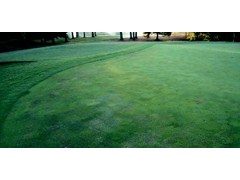
In a previous issue of Tech Notes-SH (issue 12, 2010) it was mentioned that a bacterial disease of creeping bentgrass had been reported.
In a recent publication in Plant Disease researchers from Michigan State University report the first bacterial disease on creeping bentgrass (Agrostis stolonifera) in the United States. The disease was reported on Penn G2 on greens from a golf course in North Carolina. The symptoms are similar to bacterial wilt on Poa annua (link to bacterial wilt) caused by Xanthomonas translucens pv. poae. The bacterium that causes the bacterial disease on creeping bentgrass was identified in the Acidovorax genus. The bacterium was confirmed as the causal agent through Koch's postulates.
This past summer in the United States turf decline has been reported due to bacteria. Most recently the USGA sent out a survey to golf courses trying to find out how may courses had the problem.
Caution should be practiced when bacteria assumed to be the problem. On creeping bentgrass and Poa annua greens under stress, it is common to find bacteria. In many cases, it is likely that the summer conditions were the primary reason for decline and bacteria became a secondary issue. However, it appears now that certain genus of bacteria can attack at least a few creeping bentgrass cultivars under high stress conditions.
New report may provide insight into the management of warm season grasses
In case you are not aware, a report entitled "Management Guidelines for New Warm Season Grasses in Australia" was released recently. The primary author of the report is Matt Rouche, Acting Senior Scientist for Agri Science Queensland. The report can be downloaded here.
The report is comprehensive summary of the research done on seashore paspalum and couchgrass ultradwarf varieties under golf green management. In future issues we hope to highlight some of those findings.
